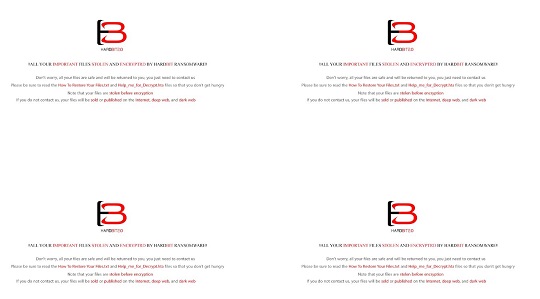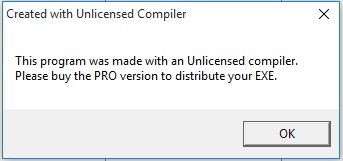Ransom.MSIL.HARDBIT.THAODBC
UDS:Trojan.MSIL.DelShad.gen (KASPERSKY) ; Ransom:Win32/Hardbit!MTB (MICROSOFT)
Windows

Tipo di minaccia informatica:
Ransomware
Distruttivo?:
No
Crittografato?:

In the wild::
Sì
Panoramica e descrizione
It arrives on a system as a file dropped by other malware or as a file downloaded unknowingly by users when visiting malicious sites.
Dettagli tecnici
Detalles de entrada
It arrives on a system as a file dropped by other malware or as a file downloaded unknowingly by users when visiting malicious sites.
Instalación
Infiltra los archivos siguientes:
- %User Profile%\DOCUMENTS\hrdb.ico → icon used for all encrypted files
- %Desktop%\HARDBIT.jpg → image used as system wallpaper after encryption
- %User Temp%\lsm.exe → detected as TROJ_GEN.R002H09HJ23
- %User Temp%\is64.txt → identifies the OS architecture
- %User Temp%\is64.bat
- %User Temp%\is64.fil → contains the path to the 64-bit cmd.exe
(Nota: %User Profile% es la carpeta de perfil del usuario activo, que en el caso de Windows 98 y ME suele estar en C:\Windows\Profiles\{nombre de usuario}, en el caso de Windows NT en C:\WINNT\Profiles\{nombre de usuario}, en el caso de Windows 2000(32-bit), XP y Server 2003(32-bit) en C:\Documents and Settings\{nombre de usuario} y en el caso de Windows Vista, 7, 8, 8.1, 2008(64-bit), 2012(64-bit) y 10(64-bit) en C:\Users\{nombre de usuario}).
. %Desktop% es la carpeta Escritorio del usuario activo, que en el caso de Windows 98 y ME suele estar en C:\Windows\Profiles\{nombre de usuario}\Escritorio, en el caso de Windows NT en C:\WINNT\Profiles\{nombre de usuario}\Escritorio, en el caso de Windows 2000(32-bit), XP y Server 2003(32-bit) en C:\Documents and Settings\{nombre de usuario}\Escritorio y en el caso de Windows Vista, 7, 8, 8.1, 2008(64-bit), 2012(64-bit) y 10(64-bit) en C:\Users\{nombre de usuario}\Desktop).. %User Temp% es la carpeta Temp del usuario activo, que en el caso de Windows 2000(32-bit), XP y Server 2003(32-bit) suele estar en C:\Documents and Settings\{nombre de usuario}\Local Settings\Temp y en el case de Windows Vista, 7, 8, 8.1, 2008(64-bit), 2012(64-bit) y 10(64-bit) en C:\Users\{nombre de usuario}\AppData\Local\Temp).)Agrega los procesos siguientes:
- cmd.exe /C sc delete VSS
- cmd.exe /C wbadmin delete catalog -quiet
- cmd.exe /C vssadmin delete shadows /all /quiet & wmic shadowcopy deletee
- cmd.exe /C bcdedit /set {default} bootstatuspolicy ignoreallfailures & bcdedit /set {default} recoveryenabled no
- "powershell" Get-MpPreference -verbose
- net.exe stop avpsus /y
- net.exe stop McAfeeDLPAgentService /y
- net.exe stop mfewc /y
- net.exe stop BMR Boot Service /y
- net.exe stop NetBackup BMR MTFTP Service /y
- net.exe stop DefWatch /y
- net.exe stop ccEvtMgr /y
- net.exe stop ccSetMgr /y
- net.exe stop SavRoam /y
- net.exe stop RTVscan /y
- net.exe stop QBFCService /y
- net.exe stop QBIDPService /y
- net.exe stop IntuitQuickBooksFCS /y
- net.exe stop QBCFMonitorService /y
- net.exe stop YooBackup /y
- net.exe stop YooIT /y
- net.exe stop zhudongfangyu /y
- net.exe stop stc_raw_agent /y
- net.exe stop VSNAPVSS /y
- net.exe stop VeeamTransportSvc /y
- net.exe stop VeeamDeploymentService /y
- net.exe stop VeeamNFSSvc /y
- net.exe stop veeam /y
- net.exe stop PDVFSService /y
- net.exe stop BackupExecVSSProvider /y
- net.exe stop BackupExecAgentAccelerator /y
- net.exe stop BackupExecAgentBrowser /y
- net.exe stop BackupExecDiveciMediaService /y
- net.exe stop BackupExecJobEngine /y
- net.exe stop BackupExecManagementService /y
- net.exe stop BackupExecRPCService /y
- net.exe stop AcrSch2Svc /y
- net.exe stop AcronisAgent /y
- net.exe stop CASAD2DWebSvc /y
- net.exe stop CAARCUpdateSvc /y
- net.exe stop sophos /y
- net.exe stop -n apache24
- net.exe stop mysql57
- net.exe wrapper
- net.exe DefWatch
- net.exe stop SavRoam /y
- net.exe stop Sqlservr /y
- net.exe stop sqlagent /y
- net.exe stop sqladhlp /y
- net.exe stop Culserver /y
- net.exe stop sqlbrowser /y
- net.exe stop QLADHLP /y
- net.exe stop Intuit /y
- net.exe stop QuickBooks /y
- net.exe stop FCS /y
- net.exe stop msmdsrv /y
- net.exe stop tomcat6 /y
- net.exe stop vmware /y
- net.exe stop vmware-converter /y
- net.exe stop dbsrv12 /y
- net.exe stop dbeng8 /y
- net.exe stop MSSQL$MICROSOFT /y
- net.exe stop ##WID /y
- net.exe stop MSSQL$VEEAMSQL2012 /y
- net.exe stop SQLAgent$VEEAMSQL2012 /y
- net.exe stop SQLBrowser /y
- net.exe stop SQLWriter /y
- net.exe stop FishbowlMySQL /y
- net.exe stop MySQL57 /y
- net.exe stop MSSQL$KAV_CS_ADMIN_KIT /y
- net.exe stop MSSQLServerADHelper100 /y!
- net.exe stop SQLAgent$KAV_CS_ADMIN_KIT /y
- net.exe stop msftesql /y
- net.exe stop Exchange /y
- net.exe stop MSSQL$MICROSOFT##SSEE /y
- net.exe stop MSSQL$SBSMONITORING /y
- net.exe stop MSSQL$SHAREPOINT /y
- net.exe stop MSSQLFDLauncher$SBSMONITORING /y
- net.exe stop SQLAgent$SBSMONITORING /y
- net.exe stop SQLAgent$SHAREPOINT /y
- net.exe stop QBVSS /y
- net.exe stop vss /y
- net.exe stop sql /y
- net.exe stop svc$ /y
- net.exe stop MSSQL /y
- net.exe stop MSSQL$ /y
- net.exe stop memtas /y
- net.exe stop mepocs /y
- net.exe stop backup /y
- net.exe stop bedbg /y
- net.exe stop MVArmor /y
- net.exe stop MVarmor64 /y
- net.exe stop ARSM /y
- net.exe stop WSBExchange /y
- net.exe stop MSExchange /y
- net.exe stop MSExchange$ /y
- %User Temp%\lsm.exe
- %User Temp%\is64.bat
- "%System%\mshta.exe" "%User Temp%\readme-warning.hta"
(Nota: %User Temp% es la carpeta Temp del usuario activo, que en el caso de Windows 2000(32-bit), XP y Server 2003(32-bit) suele estar en C:\Documents and Settings\{nombre de usuario}\Local Settings\Temp y en el case de Windows Vista, 7, 8, 8.1, 2008(64-bit), 2012(64-bit) y 10(64-bit) en C:\Users\{nombre de usuario}\AppData\Local\Temp).
. %System% es la carpeta del sistema de Windows, que en el caso de Windows 98 y ME suele estar en C:\Windows\System, en el caso de Windows NT y 2000 en C:\WINNT\System32 y en el caso de Windows 2000(32-bit), XP, Server 2003(32-bit), Vista, 7, 8, 8.1, 2008(64-bit), 2012(64bit) y 10(64-bit) en C:\Windows\System32).)Crea las carpetas siguientes:
- %User Temp%\myfiles
- %User Temp%\wxy
(Nota: %User Temp% es la carpeta Temp del usuario activo, que en el caso de Windows 2000(32-bit), XP y Server 2003(32-bit) suele estar en C:\Documents and Settings\{nombre de usuario}\Local Settings\Temp y en el case de Windows Vista, 7, 8, 8.1, 2008(64-bit), 2012(64-bit) y 10(64-bit) en C:\Users\{nombre de usuario}\AppData\Local\Temp).
)Otras modificaciones del sistema
Agrega las siguientes entradas de registro:
HKEY_USERS\{SID}_CLASSES\.hardbit2\
DefaultIcon
(Default) = %User Profile%\Documents\hrdb.ico
Agrega las siguientes claves de registro como parte de la rutina de instalación:
HKEY_USERS\{SID}_CLASSES\.hardbit2
HKEY_USERS\{SID}_CLASSES\.hardbit2\
DefaultIcon
Modifica las siguientes entradas de registro:
HKEY_LOCAL_MACHINE\SOFTWARE\Policies\
Microsoft\Windows Defender
DisableAntiSpyware = 1
(Note: The default value data of the said registry entry is 0.)
HKEY_LOCAL_MACHINE\SOFTWARE\Policies\
Microsoft\Windows Defender\Real-Time Protection
DisableBehaviorMonitoring = 1
(Note: The default value data of the said registry entry is 0.)
HKEY_LOCAL_MACHINE\SOFTWARE\Policies\
Microsoft\Windows Defender\Real-Time Protection
DisableOnAccessProtection = 1
(Note: The default value data of the said registry entry is 0.)
HKEY_LOCAL_MACHINE\SOFTWARE\Policies\
Microsoft\Windows Defender\Real-Time Protection
DisableScanOnRealtimeEnable = 1
(Note: The default value data of the said registry entry is 0.)
Cambia el fondo de escritorio mediante la modificación de las siguientes entradas de registro:
HKEY_CURRENT_USER\Control Panel\Desktop
Wallpaper = %Desktop%\HARDBIT.jpg
Este malware establece la imagen siguiente como fondo de escritorio del sistema:
- %Desktop%\HARDBIT.jpg

Finalización del proceso
Finaliza los servicios siguientes si los detecta en el sistema afectado:
- avpsus
- McAfeeDLPAgentService
- mfewc
- BMR Boot Service
- NetBackup BMR MTFTP Service
- DefWatch
- ccEvtMgr
- ccSetMgr
- SavRoam
- RTVscan
- QBFCService
- QBIDPService
- IntuitQuickBooksFCS
- QBCFMonitorService
- YooBackup
- YooIT
- zhudongfangyu
- stc_raw_agent
- VSNAPVSS
- VeeamTransportSvc
- VeeamDeploymentService
- VeeamNFSSvc
- veeam
- PDVFSService
- BackupExecVSSProvider
- BackupExecAgentAccelerator
- BackupExecAgentBrowser
- BackupExecDiveciMediaService
- BackupExecJobEngine
- BackupExecManagementService
- BackupExecRPCService
- AcrSch2Svc
- AcronisAgent
- CASAD2DWebSvc
- CAARCUpdateSvc
- sophos
- apache24
- mysql57
- SavRoam
- Sqlservr
- sqlagent
- sqladhlp
- Culserver
- sqlbrowser
- QLADHLP
- Intuit
- QuickBooks
- FCS
- msmdsrv
- tomcat6
- vmware
- vmware-converter
- dbsrv12
- dbeng8
- MSSQL$MICROSOFT
- ##WID
- MSSQL$VEEAMSQL2012
- SQLAgent$VEEAMSQL2012
- SQLBrowser
- SQLWriter
- FishbowlMySQL
- MySQL57
- MSSQL$KAV_CS_ADMIN_KIT
- MSSQLServerADHelper100!
- SQLAgent$KAV_CS_ADMIN_KIT
- msftesql
- Exchange
- MSSQL$MICROSOFT##SSEE
- MSSQL$SBSMONITORING
- MSSQL$SHAREPOINT
- MSSQLFDLauncher$SBSMONITORING
- SQLAgent$SBSMONITORING
- SQLAgent$SHAREPOINT
- QBVSS
- vss
- sql
- svc$
- MSSQL
- MSSQL$
- memtas
- mepocs
- backup
- bedbg
- MVArmor
- MVarmor64
- ARSM
- WSBExchange
- MSExchange
- MSExchange$
Finaliza los procesos siguientes si detecta que se ejecutan en la memoria del sistema afectado:
- 360Doctor
- 360Se
- acwebbrowser
- ADExplorer
- ADExplorer64
- ADExplorer64a
- Adobe
- AdobeCollabSync
- AdobeIPCBroker
- agntsvc
- AutodeskDesktopApp
- Autoruns
- Autoruns64
- Autoruns64a
- Autorunsc
- Autorunsc64
- Autorunsc64a
- avz
- axlbridge
- bedbh
- benetns
- bengien
- beserver
- BrCcUxSys
- BrCtrlCntr
- CagService
- calc
- CEF
- Cloud
- CoreSync
- Creative
- Culture
- dbeng50
- dbsnmp
- Defwatch
- DellSystemDetect
- dumpcap
- encsvc
- EnterpriseClient
- excel
- fbguard
- fbserver
- fdhost
- fdlauncher
- firefox
- GDscan
- GlassWire
- GWCtlSrv
- Helper
- httpd
- infopath
- InputPersonalization
- isqlplussvc
- j0gnjko1
- java
- koaly-exp-engine-service
- msaccess
- mspub
- mydesktopqos
- mydesktopservice
- mysqld
- node
- notepad
- notepad++
- ocautoupds
- ocomm
- ocssd
- onedrive
- onenote
- ONENOTEM
- oracle
- outlook
- powerpnt
- ProcessHacker
- Procexp
- Procexp64
- procexp64a
- procmon
- procmon64
- procmon64a
- pvlsvr
- QBDBMgr
- QBDBMgrN
- QBIDPService
- qbupdate
- QBW32
- Raccine
- Raccine_x86
- RaccineElevatedCfg
- RaccineSettings
- RAgui
- raw_agent_svc
- RdrCEF
- RTVscan
- sam
- Service
- SimplyConnectionManager
- SimplySystemTrayIcon
- sqbcoreservice
- sqlbrowser
- sqlmangr
- Sqlservr
- Ssms
- steam
- supervise
- sync
- synctime
- Sysmon
- Sysmon64
- SystemExplorer
- SystemExplorerService
- SystemExplorerService64
- taskbar
- tbirdconfig
- tcpview
- tcpview64
- tcpview64a
- tdsskiller
- TeamViewer
- TeamViewer_Service
- thebat
- thunderbird
- TitanV
- tomcat6
- Totalcmd
- Totalcmd64
- tv_w32
- tv_x64
- VeeamDeploymentSvc
- visio
- vsnapvss
- vss
- vxmon
- wdswfsafe
- winword
- WireShark
- wordpad
- worker
- wsa_service
- wuauclt
- wxServer
- wxServerView
- xfssvccon
- ZhuDongFangYu
Robo de información
Recopila los siguientes datos:
- Hardware information (CPU, Disk Drives, Graphics Card, Manufacturer, BIOS)
- Network adapter settings (IP configuration, MAC address)
- Username
- Computer Name
- Timezone Information
Otros detalles
Hace lo siguiente:
- It changes the encrypted file icon to the following image:

- %User Temp%\lsm.exe shows the following message box:

Soluzioni
Step 2
Los usuarios de Windows ME y XP, antes de llevar a cabo cualquier exploración, deben comprobar que tienen desactivada la opción Restaurar sistema para permitir la exploración completa del equipo.
Step 3
Note that not all files, folders, and registry keys and entries are installed on your computer during this malware's/spyware's/grayware's execution. This may be due to incomplete installation or other operating system conditions. If you do not find the same files/folders/registry information, please proceed to the next step.
Step 4
Restaurar este valor del Registro modificado
Importante: si modifica el Registro de Windows incorrectamente, podría hacer que el sistema funcione mal de manera irreversible. Lleve a cabo este paso solo si sabe cómo hacerlo o si puede contar con ayuda de su administrador del sistema. De lo contrario, lea este artículo de Microsoft antes de modificar el Registro del equipo.
- HKEY_LOCAL_MACHINE\SOFTWARE\Policies\Microsoft\Windows Defender
- DisableAntiSpyware=1
- DisableAntiSpyware=0
- HKEY_LOCAL_MACHINE\SOFTWARE\Policies\Microsoft\Windows Defender\Real-Time Protection
- DisableBehaviorMonitoring=1
- DisableBehaviorMonitoring= 0
- HKEY_LOCAL_MACHINE\SOFTWARE\Policies\Microsoft\Windows Defender\Real-Time Protection
- DisableOnAccessProtection=1
- DisableOnAccessProtection= 0
- HKEY_LOCAL_MACHINE\SOFTWARE\Policies\Microsoft\Windows Defender\Real-Time Protection
- DisableScanOnRealtimeEnable=1
- DisableScanOnRealtimeEnable= 0
Step 5
Delete this registry key
=Important: Editing the Windows Registry incorrectly can lead to irreversible system malfunction. Please do this only if you know how to or you can seek your system administrator’s help. You may also check out this Microsoft article first before modifying your computer's registry.
- In HKEY_USERS\{SID}_CLASSES\.hardbit2
Step 6
Buscar y eliminar este archivo
- {Encrypted Directory}\How To Restore Your Files.txt
- {Encrypted Directory}\Help_me_for_Decrypt.hta
- %User Temp%\readme-warning.hta
- %User Profile%\DOCUMENTS\hrdb.ico
- %User Temp%\lsm.exe
- %User Temp%\is64.txt
- %User Temp%\is64.bat
- %User Temp%\is64.fil
- %Desktop%\HARDBIT.jpg
Step 7
Buscar y eliminar estas carpetas
- %User Temp%\myfiles
- %User Temp%\wxy
Step 8
Explorar el equipo con su producto de Trend Micro para eliminar los archivos detectados como Ransom.MSIL.HARDBIT.THAODBC En caso de que el producto de Trend Micro ya haya limpiado, eliminado o puesto en cuarentena los archivos detectados, no serán necesarios más pasos. Puede optar simplemente por eliminar los archivos en cuarentena. Consulte esta página de Base de conocimientos para obtener más información.
Step 9
Restablecer las propiedades del escritorio
Step 10
Restore encrypted files from backup.
Sondaggio

